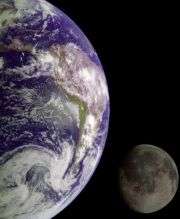Gravity wells could provide 'parking lots' for spaceships

Nature has provided five huge rest stops far out in space for the convenience of spacecraft traveling from Earth. Some NASA folks call them "parking lots" in space.
They're unusual locations where gravity loses its pull and a spaceship can loiter, rather like a marble at the bottom of a cup, without using a lot of fuel. Three of them are 930,000 miles outside Earth's orbit. One is between the Earth and the sun, and another is hidden on the far side of the sun.
A pair of U.S. unmanned scientific satellites will pass through two of these sites this fall. NASA may eventually park a permanent space weather station at one of them.
Their scientific names are Lagrange points, after the French mathematician Joseph-Louis Lagrange, who predicted their existence more than 200 years ago.
Numbered L1, L2, L3, L4 and L5, they're really just mathematical points marking the centers of "gravity wells" -- places where the gravity of the Earth and the sun cancel each other out. However, the effect of their reduced gravity extends for millions of miles around the points.
The two approaching spaceships belong to NASA's STEREO mission, which was launched in October 2006, to study the sun and its effect on space weather.
One of them, STEREO A, nicknamed "Ahead," will reach L4, 930,000 miles beyond Earth's orbit on the side away from the sun, on Sept. 10. STEREO B, a laggard labeled "Behind," should get to L5, also facing the nightside of Earth, on Oct. 26.
STEREO A and B "are already under the influence of the Lagrange points," said William Thompson, a solar scientist at NASA's Goddard Space Flight Center in Greenbelt, Md. "It takes several months for them to pass through the regions around the L4-L5 points."
There are no plans to slow or halt Ahead or Behind as they enter the gravity wells. "We're moving too fast to get stuck," Michael Kaiser, retired STEREO project scientist, wrote in an e-mail.
Early next year, two European space telescopes, named Herschel and Planck, which were launched on May 14, will reach L2, the Lagrange point between L4 and L5.
Astronomers think L2, which also is 930,000 miles beyond Earth's orbit and far from its shadow, is an ideal setting to observe the universe. It will be the future home of the James Webb Space Telescope, which is to be launched in 2014 to succeed NASA's champion Hubble telescope.
Already parked at L2 is WMAP (the Wilkinson Microwave Anisotropy Probe), a NASA mission that launched in 2001 and has been making detailed observations of the early universe.
L1, a tenth of the way toward the sun, is occupied by SOHO, the U.S.-European Solar and Heliospheric Observatory. SOHO constantly monitors the sun to provide early warning of violent solar storms that can wreak havoc on earthly communications and endanger astronauts.
L3 is permanently hidden on the opposite side of the sun from Earth. Because it's invisible, it's been an ideal spot for science-fiction fantasies about alien spacecraft or a mysterious "Planet X."
After passing through L4 and L5, Ahead and Behind will continue circling the sun indefinitely, or until NASA cuts off their $10 million a year support.
"By early 2011, on Super Bowl Sunday, the two spacecraft will be 180 degrees apart and able, for the first time, to provide a view of the entire sun, front and back simultaneously," Kaiser said.
Meanwhile, Thompson said the STEREO mission will serve as "a test bed for a possible future space weather mission to be parked at L5."
Astronomers also think that L4 and L5 are natural dumps for space dust, debris, small asteroids and perhaps the remains of an ancient planet.
Two Princeton University astrophysicists, Edward Belbruno and Richard Gott, have speculated in books and lectures that a hypothetical planet, which they call Theia, was nudged out of its resting place when the solar system was still forming, 4.5 billion years ago, and plunged toward Earth. The subsequent collision knocked off a huge mass of material that later became the moon.
"These places may hold small asteroids, which could be leftovers from a Mars-sized planet that formed billions of years ago," Kaiser said. "A lot of this stuff could be remnants of Theia."
___
(c) 2009, McClatchy-Tribune Information Services.
Visit the McClatchy Washington Bureau on the World Wide Web at www.mcclatchydc.com


















